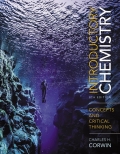
(a)
Interpretation:
The Latin system name for ionic compound
Concept introduction:
The Latin system is an old method for naming metal cations which have two ionic charges. The Latin system is also known as the suffix system because this system uses the Latin name of the metal and applies the suffix –ous or –ic. For the lower ionic charge, the suffix “–ous” is used and for the the higher ionic charge, the suffix“–ic” is used.
Answer to Problem 45E
The Latin system name for ionic compound
Explanation of Solution
The Latin name for the copper is cuprum. In ionic compound
The Latin system name for ionic compound
(b)
Interpretation:
The Latin system name for ionic compound
Concept introduction:
The Latin system is an old method for naming metal cations which have two ionic charges. The Latin system is also known as the suffix system because this system uses the Latin name of the metal and applies the suffix “–ous” or “–ic”. For the lower ionic charge, the suffix “–ous” is used and for the the higher ionic charge, the suffix“–ic” is used.
Answer to Problem 45E
The Latin system name for ionic compound
Explanation of Solution
The Latin name of iron is ferrum. In the ionic compound
The Latin system name for ionic compound
(c)
Interpretation:
The Latin system name for ionic compound
Concept introduction:
The Latin system is an old method for naming metal cations which have two ionic charges. The Latin system is also known as the suffix system because this system uses the Latin name of the metal and applies the suffix “–ous” or “–ic”. For the lower ionic charge, the suffix “–ous” is used and for the the higher ionic charge, the suffix“–ic” is used.
Answer to Problem 45E
The Latin system name for ionic compound
Explanation of Solution
The Latin name of mercury is hydrargyrum or mercurum. In the ionic compound
The Latin system name for ionic compound
(d)
Interpretation:
The Latin system name for ionic compound
Concept introduction:
The Latin system is an old method for naming metal cations which have two ionic charges. The Latin system is also known as the suffix system because this system uses the Latin name of the metal and applies the suffix “–ous” or “–ic”. For the lower ionic charge, the suffix “–ous” is used and for the the higher ionic charge, the suffix“–ic” is used.
Answer to Problem 45E
The Latin system name for ionic compound
Explanation of Solution
The Latin name of the lead is plumbum. In the ionic compound
The Latin system name for ionic compound
Want to see more full solutions like this?
Chapter 6 Solutions
EBK INTRODUCTORY CHEMISTRY
- :0: :0: Select to Add Arrows :0: (CH3)2NH :0: ■ Select to Add Arrows :0: :0: (CH3)2NH ■ Select to Add Arrowsarrow_forwardDraw the product of the following H action sequence. Ignore any inorganic byproducts formed. 1. (CH3CH2)2CuLi, THF 2. CH3Br Q Atoms, Bonds and Rings H Charges ㅁarrow_forwardPlease help me with this the problem is so confusingarrow_forward
- 14 Question (1 point) Disiamylborane adds to a triple bond to give an alkenylborane. Upon oxidation with OH, H2O2, the alkenylborane will form an enol that tautomerizes to an aldehyde. In the first box below, draw the mechanism arrows for the reaction of disiamylborane with the alkyne, and in the last box draw the structure of the aldehyde. 4th attempt Feedback i > 3rd attempt OH, H2O2 i See Periodic Table See Hintarrow_forwardanswer with mechanisms and steps. handwritten please!arrow_forwardHello I need some help with Smartwork. For drawing structure B, I know the correct answer is CH₃B₂, but when I try to type it in, it keeps giving me CH₄BH₃ instead. Do you know how I should write it properly? Should I use a bond or something else?arrow_forward
 ChemistryChemistryISBN:9781305957404Author:Steven S. Zumdahl, Susan A. Zumdahl, Donald J. DeCostePublisher:Cengage Learning
ChemistryChemistryISBN:9781305957404Author:Steven S. Zumdahl, Susan A. Zumdahl, Donald J. DeCostePublisher:Cengage Learning ChemistryChemistryISBN:9781259911156Author:Raymond Chang Dr., Jason Overby ProfessorPublisher:McGraw-Hill Education
ChemistryChemistryISBN:9781259911156Author:Raymond Chang Dr., Jason Overby ProfessorPublisher:McGraw-Hill Education Principles of Instrumental AnalysisChemistryISBN:9781305577213Author:Douglas A. Skoog, F. James Holler, Stanley R. CrouchPublisher:Cengage Learning
Principles of Instrumental AnalysisChemistryISBN:9781305577213Author:Douglas A. Skoog, F. James Holler, Stanley R. CrouchPublisher:Cengage Learning Organic ChemistryChemistryISBN:9780078021558Author:Janice Gorzynski Smith Dr.Publisher:McGraw-Hill Education
Organic ChemistryChemistryISBN:9780078021558Author:Janice Gorzynski Smith Dr.Publisher:McGraw-Hill Education Chemistry: Principles and ReactionsChemistryISBN:9781305079373Author:William L. Masterton, Cecile N. HurleyPublisher:Cengage Learning
Chemistry: Principles and ReactionsChemistryISBN:9781305079373Author:William L. Masterton, Cecile N. HurleyPublisher:Cengage Learning Elementary Principles of Chemical Processes, Bind...ChemistryISBN:9781118431221Author:Richard M. Felder, Ronald W. Rousseau, Lisa G. BullardPublisher:WILEY
Elementary Principles of Chemical Processes, Bind...ChemistryISBN:9781118431221Author:Richard M. Felder, Ronald W. Rousseau, Lisa G. BullardPublisher:WILEY





